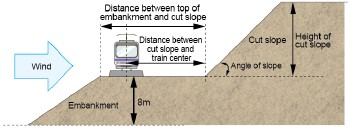6. Calculation of the aerodynamic coefficient on trains in half-bank half-cut line sections
Evaluation of running safety in high winds is carried out using an aerodynamic coefficient obtained from wind-tunnel tests. There are many types of section topography along actual railway lines, however, the aerodynamic coefficient is sought for seven standard types of track-side structure. Many lines close to the coast or rivers are often on tracks flanked by a slope on one side and a bank on the other (half-bank half-cut sections), and are treated as embankments. However, on sections with high embankments on the downwind side, the lateral force acting on the train is lower than on normal embankments, which means that the aerodynamic coefficient is probably smaller.
Therefore, wind-tunnel tests were conducted to obtain the aerodynamic coefficient on a half-bank half-cut section. During the wind-tunnel tests, the angle and height of the cut slope was varied along with the distance between the cut slope and the train center (Fig.1).
Results showed that in cases where the cut slope was 10 m or 15 m, as the distance grew shorter between the side of the train and flanking cut slope, and as the angle of the slope became steeper, the lateral forces acting on the intermediate carriages of the train at 90 degrees fell between 5-100% (Fig. 2).
The outcome of these experiments shows that safety evaluation of half-bank half-cut sections can be carried out more suitably than simply applying the standard embankment evaluation method used previously.
Other Contents
- 1. Advanced seismograph for earthquake early warnings
- 2.Method for extracting vulnerable structures during earthquakes
- 3.Seismic reinforcement technology for earth retaining walls in narrow locations
- 4. Method for assessing tsunami damage to concrete bridges
- 5. Management of snowmelt for landslide prevention
- 6. Calculation of the aerodynamic coefficient on trains in half-bank half-cut line sections
- 7. Revision of evaluation criteria to check deterioration in lubricating grease used on trains
- 8.Method for detecting step-shaped wear on contact strips on pantograph heads
- 9.Improving lightening resistance of electrical equipment using new grounding structure
- 10.Proposal of method for diagnosing health of concrete masts for maintenance
- 11.On-board platform detection device to assist train crew in train door operation
- 12.Human factor analysis method using Potential Incidents Reports
- 1. Advanced seismograph for earthquake early warnings
- 2.Method for extracting vulnerable structures during earthquakes
- 3.Seismic reinforcement technology for earth retaining walls in narrow locations
- 4. Method for assessing tsunami damage to concrete bridges
- 5. Management of snowmelt for landslide prevention
- 6. Calculation of the aerodynamic coefficient on trains in half-bank half-cut line sections
- 7. Revision of evaluation criteria to check deterioration in lubricating grease used on trains
- 8.Method for detecting step-shaped wear on contact strips on pantograph heads
- 9.Improving lightening resistance of electrical equipment using new grounding structure
- 10.Proposal of method for diagnosing health of concrete masts for maintenance
- 11.On-board platform detection device to assist train crew in train door operation
- 12.Human factor analysis method using Potential Incidents Reports


